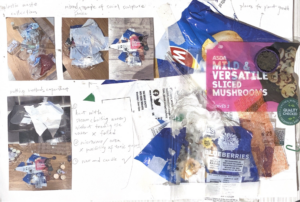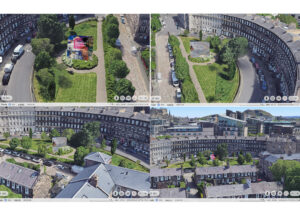WEEK8-Vital Materialism
Keep the Awareness
Penny Spark’s The Age of Plastic and Gabrys et al’s Accumulation. They are not just texts, but mirrors to the complex cultural significance of materials like plastic that embody both decline and progress. Reading this book made me think critically about my personal position as a designer in a wider context. How can I contribute to a more sustainable narrative as a citizen and creator?

Figure 1: Plastic Beach (detail), Robert Callender, 2003 - 2008
My practice must evolve to achieve a future where materials are not only used, but become part of a cycle of regeneration and respect. As Kate Franklin and Caroline Teale suggest, this includes a shift from linear to circular thinking, where waste is viewed as raw material. It is not just about designing for today, but also for the legacy we leave behind.
My work as a designer is not an isolated undertaking, but a dance with the global environment, deeply connected to the political ecology of design. It is sobering that each choice of material has an impact far beyond the studio. The environmental crisis is not just a distant phenomenon. It is the canvas on which we paint our works, and the palette we use is shaped by the original literature and thinking that guides our hands.

Figure 2: Plastic Waste Remake Process, Sally Li, 2024

Figure 3: Social Sculpture 'Intarvention' in Gardner's Crescent Garden, Sally Li, 2024
Breath
In this public talk, Jennifer will use materials from her forthcoming book, Global Citizens: An Outdoor Toolkit for Environmental Action, to explore how environmental sensing technologies can shape atmospheric citizenship and create a more breathable world. She will discuss collaborative efforts to monitor air pollution from fracking infrastructure, record emissions in urban environments, and create air quality gardens. As these projects demonstrate, how people respond to, care for, and fight changing environmental conditions has implications for political actors and groups seeking to create a kinder world.
I believe my field has a responsibility to promote critical conversations about the impact of design on the environment. This includes not only the physical products we create, but also the cultural stories we perpetuate. As a designer, I am a storyteller, and the stories I tell must be sustainable and regenerative.
From the disappearance of plastic to the possibilities of radical materials, my thinking about the course topics has been a journey of critical reading and creative response. I have tried to communicate these ideas in a variety of ways: visually through projects, through verbal discussions, and now in writing. Each strategy is a tool to engage with the world, inspire thought, and inspire action to achieve a more harmonious coexistence with the environment.
Workshop

Figure 4: Plastic Hybrid, Sally Li, 2024


Figure 5: Raw Materials and Making Process, Sally Li, 2024
What are vital materials? Plastic can breathe too. ‘If matter itself is lively, then not only is the difference between subjects and objects minimized, but the status of the shared materiality of all things is elevated.’ The vase I created was intended to highlight the conceptual idea of materials being important in design practice. The vase has channels that allow the flowers more air, acting as an airway, but also showing that they are a living plastic mix. Interestingly, during the process of creating the vase, sometimes pieces of the vase would fall out, making it more like a living thing.
bibliography
Franklin, K. and Till, C. (2019). Radical matter : rethinking materials for a sustainable future. London Thames Et Hudson.
Gabrys, J., Hawkins, G. and Michael, M. (2017). Accumulation : the material politics of plastic. London: Routledge.
Sparke, P. (1993). The Plastics Age. Overlook Books.
Figure 1: Bremner, A. (2003). ‘Plastic Beach’ (detail). Courtesy of the Estate of Robert Callender. Available at: https://www.artrabbit.com/events/robert-callender-plastic-beach-poetry-of-the-everyday [Accessed 8 Nov. 2024].
Figure 2,3,4,5 are my own work